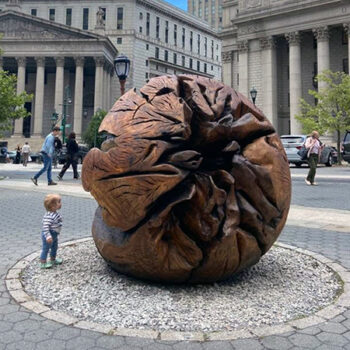
13 MOONS
(Seeds)
THOMAS PAINE PARK – FOLEY SQUARE
Manhattan / New York City – USA
EXHIBITION (Curatorship: Gustavo Buntinx)
21 de junio
20 de junio
2022 – 2023
THE BROKEN<br />BOUGH<br />(Reborn)</em><br>(Curatorial essay)<br>Gustavo Buntinx
Gustavo Buntinx
THE BROKEN BOUGH
(Reborn)
(Curatorial essay) (*)

Remains of illegally plundered trees
being rescued by Jaime Miranda-Bambarén’s Seeds project
2013
(Photographer: Juan Manuel Olivera)
— I —
OVERTURE
“While at rest on a summer’s noon”, Walter Benjamin famously wrote in 1931, “to calmly follow with the gaze the profile of a range of mountains on the horizon, or a branch which casts its shadow on the observer, until the moment or the hour become part of their apparition —this is what it means to breathe the aura of those mountains, that branch.”
That branch is fallen. Fractured. The Broken Bough. Both in a literal and in a terribly metaphorical sense: the deforestation of the Earth is also the devastation of our soul.
Our personal and collective spirit: damned we are —and blessed— with the unasked privilege of travailing through life in these liminal, perhaps terminal times for the human condition. Martin Heidegger and Walter Benjamin, now strangely twinned by the complementary opposites of their premonitions. The hollowing out of the Earth, the darkening of the World, the flight of the Gods. The grinding away of the Aura.
But in confronting that abyss heed must also be paid to the afterlife of it all. Its posthumous illuminations, its other epiphanies.
The respiration, the inspiration. The phantom breath that might also expire into that deep night. But not without a battle: art, too, is reborn in the agony of art, in its fight to the death with death itself.
In its rage against the dying of the light.
— II —
DRIFTWOOD
A furtive, almost hallucinatory struggle.
As in the anguished harvesting of the “hidden bones of the forest” through which Jaime Miranda-Bambarén exhumes the truncated roots of so many mutilated trees in the towns and in the fields of a Peruvian landscape that sees its natural splendour increasingly plundered. Centennial eucalyptus, sown perhaps since viceregal times, and now systematically razed by our failed modernizations, our degrading “modernity”.
In the rescue of such remains Miranda-Bambarén affirms, to be sure, an ecological claim. But, above all, he projects a metaphysical vision, a resurrectional act: to grant those desecrated remnants a symbolic dignity. And to transfigure those mementos of death into breathtaking, almost breathing images of life.
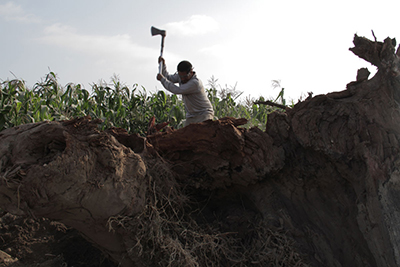
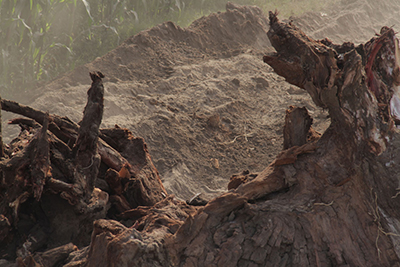 Remains of illegally plundered trees
Remains of illegally plundered trees
being rescued by Jaime Miranda-Bambarén’s Seeds project
2013
(Photographer: Juan Manuel Olivera)


Sacred icons of every tradition: our disperse human spirituality yearns to be condensed in these syncretic sculptures. Moribund nature transformed into a nascent art that Miranda sometimes returns again to nature. A few of the resulting pieces are recognizable in their figurative intent, with insinuations that often seem overtly Buddhist, or even Christian. But also archaic: in other works —of different origin, but similar essence— primordial anatomies appear barely sculpted out of the textures of the corroded timbers that supported the Victorian docks in East London. The Pillars of the Empire (2011) —such is the title of these pieces— abandoned in front of what is today the great financial center of Canary Wharf, the new “City”.
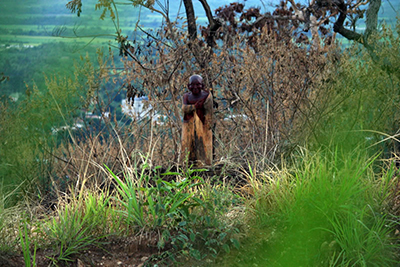
One of Miranda-Bambarén’s wooden sculptures
returned to nature in the jungles of Peru
2011
(Photographer: Lena Huber)
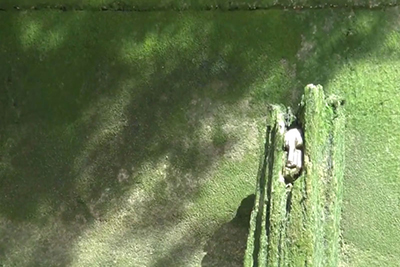
Detail of Miranda-Bambarén’s sculptural intervention
on the corroded piles of London’s abandoned docks
2011
(Still from the video The Pillars of the Empire)
The capital of capitalism, disturbed by this public and at the same time clandestine art. The totemic transformation of the ruinous piles that submerge and emerge —“hauntingly”, in the words of the artificer— amongst the shifting waters of the great river. The grand tides through which the Thames fantasizes becoming again the Ganges.
Enshrouded by that pulsional drift those eroded poles still stand erect. Like forlorn gods, like forgotten idols, like corroded phalluses. The other, tacit title of this ghostly piece could well be Driftwood. The marooned scaffolding of the shipwreck of the West.
And the drowning away of the human condition.
— III —
SEEDS
In a different avatar, other pieces by Miranda propose esoteric abstractions. As in the sensorial overflow of creviced fragments of wood, sometimes immense, that are spheres that are planets that are cells. That are Seeds, as the author calls them. The seminal power of the symbolic.
Cosmic beads of a rosary unraveled and dispersed. But recomposed.
“A poetics of resurrection,” Miranda himself explains, “in a twisted metabolization of the Catholic and baroque aesthetic project.” The result is a thaumaturgic art. Its ultimate beauty not only resides in the splendid forms of these eccentric pieces, but also emanates from the free associations and energies activated by the frictions derived from the variable surroundings of their emplacements: some artistic venues of well-established importance, but above all several suggestive public spaces and environments.

View of Miranda-Bambarén’s Seeds
at the Plaza Matriz of El Callao
2016
(Photographer: Jaime Miranda-Bambarén)
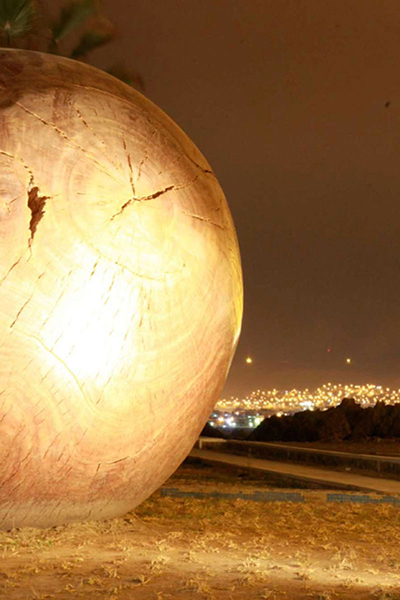
View of Miranda-Bambarén’s Seeds
at the Peruvian port city of Ilo
2012
(Photographer: Jaime Miranda-Bambarén)
The quiet plaza in front of the solemn façade of a cathedral, for example (the Iglesia Matriz of El Callao, 2016). Or the disturbed landscape of the ocean tamed into a port (Ilo, Moquegua, 2012). Or the seigneurial edifice of a transformed manor house (Casa Hacienda Moreyra, Lima, 2014). Or the sharp contrast offered by the most polished commercial architecture (Las Begonias and Miguel Dasso Streets, Lima, 2014 – 2020). And, at the extreme opposite, by the severe geometry of the 18th century garrison built for the royal escorts of the Bourbon kings (Conde Duque Cultural Center, Madrid, 2019).
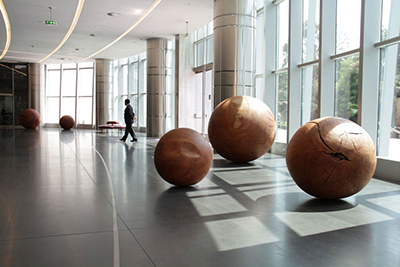
View of Miranda-Bambarén’s Seeds
at Torre Begonias, in Lima
(Peru’s first “green” corporate building)
2014
(Photographer: Jaime Miranda-Bambarén)
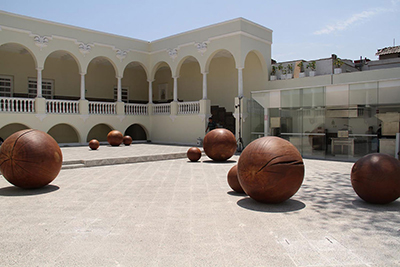
View of Miranda-Bambarén’s Seeds
at the Casa Hacienda Moreyra (Moreyra Manor House),
in Lima
2014
(Photographer: Jaime Miranda-Bambarén)

View of Miranda-Bambarén’s Seeds
at the Conde Duque Cultural Center, in Madrid
2019
(Photographer: Claudia Alva)
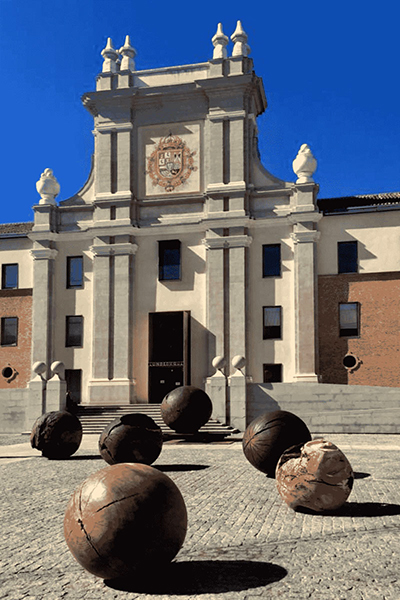
View of Miranda-Bambarén’s Seeds
at the Conde Duque Cultural Center, in Madrid
2019
(Photographer unknown)

View of the deliberately broken tile floor
at Jaime Miranda-Bambarén’s Darśan exhibition
Raúl Porras Barrenechea Gallery, Lima
2016
(Photographer: Sergio Fernández Majluf)
Or by the vulgar tile and the bleak cement of a saddened gallery-floor, which in a crucial exhibition these Seeds dramatically fracture (Darśan, Raul Porras Barrenechea Gallery, Lima, 2016). In search of the earth.
The Earth.
— IV —
13 MOONS
But it is undoubtedly in Manhattan’s Thomas Paine Park where this sculptural sowing reaches its most poignant germination: thirteen monumental wooden spheres —13 Moons— have been therein installed, in gravid allusion to the annual cycle of human ovulation.
That number, and their impressive dimensions —between 180 and 230 cm in diameter— allows the complex handling of the rhythms necessary for a subtle yet incisive resignification of the chosen ground. An impregnation with no fixed or preestablished meanings, but prolific in suggestions poetically unleashed. As in the reemergence of that which has been interred.
By nature, or by history.

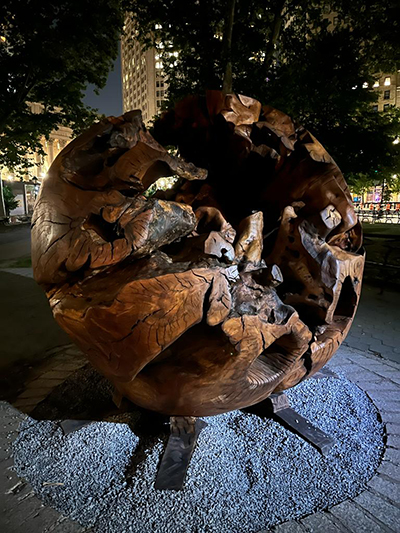
Nocturnal views of 13 Moons (Seeds),
installed at Thomas Paine Park
(Photographer: Roxana Buntinx)
A sense of latency already inscribed into the very materiality of these convoluted pieces. The dramatic outbursts of their fissures and textures. The peristaltic entrails of the savaged roots. The furrows, the gaps, the crevices. The almost erogenous conduits and orifices. The disturbing and enticing cavities provocatively probing deep into the kernel hearts of each Seed. And at times penetrating its flesh and soul to the point of occasionally breaking through its entire body to reveal, in an outburst of light, the other side of the perforated sphere.
A vision akin to the aesthetic notion of the sublime. Or the artistic experience of the spiritual.
The spiritual in art, paradoxically extracted out of the extremely physical process of cleansing the still brute substance of the unearthed roots, and then arduously exploring the creative suggestions provided by their unique marks of existence. Their grains, their knots, their voids and protuberances, their entanglements and extensions. Even the rocks occasionally enveloped —devoured— by the plant’s subterranean growth. And reverently preserved by the artwork.
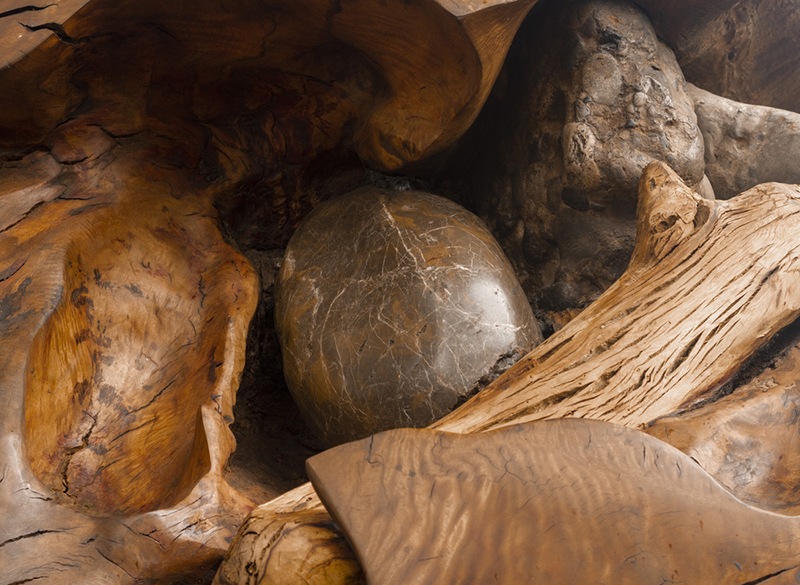
Entangled branches and rocks exposed and preserved
in one of Miranda-Bambarén’s 13 Moons (Seeds)
(Photographer: Jaime Miranda-Bambarén)
The visceral expression thus obtained is not to be confused with an expressionism. The subjectivity revealed in this process is not solely that of the artificer, but also —primordially— that of matter.
For what these works radically propose is the REmaterialization of art, brought to our sensorial perception by the intuitive dialogue between the hand and the wood. A complex dialectics, very technical at times, at times almost trance-like, to be fulfilled by an even more unpredictable interaction: the friction between the apparently completed art piece and the elements that will truly finalize it.
The elements, the atmospheric forces that will both blemish and embellish the impeccable forms withdrawn from the artist’s studio to be exposed to —rather than merely exhibited in— the open airs, and the rains, and the winds, and the smog, of Thomas Paine Park. During nineteen highly symbolic weeks: the actual process of the installation itself begun on the 21st of June —the Summer Solstice in the Northern Hemisphere— and was concluded three days later, on the 24th, in coincidence with the Inti Raymi, the grand Solar Feast of Inca times. With similar poignance, the total experience will conclude on the first of November. The Day of the Dead. And the Reborn.
That time lapse, that passage of time, is in itself part of 13 Moons. And its mark will be inscribed into both the modified appearance and the perpetual soul of the grand spheres that thus configure their final mystery. The mutual transfiguration of patina and aura.
Their reciprocal transubstantiation. Defined by the whims of nature.
Or God.
Il miglior fabbro.
— V —
CODA
Such mystical overtones, however, are discreetly diffused into the faktura of the 13 Moons. The organic exuberance and genesic connotations through which these sidereal, these telluric orbs, relate amiably with the casual strollers, inevitably captivated by the esoteric aura emanating from the sheer beauty —and the mystery— of such enchanted presences.

Joyful interactions of members of the local community with Miranda-Bambarén’s Seeds
(Photographer: Gustavo Buntinx)
But the most complex associations are those established with the site itself. And with the very soil in which these Seeds have now been resown. With multiple fructifications.
There is, of course, an essential and visible harmony with the forested surroundings. Yet a more abstract and primordial tension may be suggested with the ghost of Tilted Arc, Richard Serra’s almost funereal sculptural intervention. A blackened, hard-edge, cold-steel, massive plate controversially erected in —and eventually removed from— the adjoining Federal Plaza, some forty years ago.
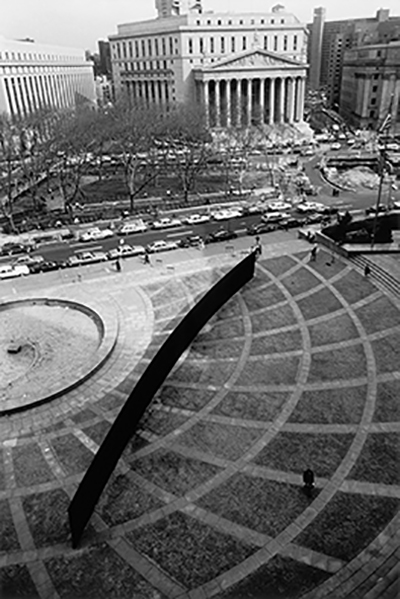
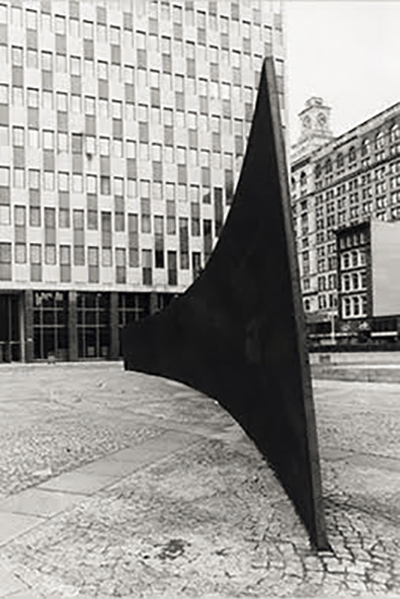
Richard Serra’s Tilted Arc, erected at Federal Plaza,
next to Thomas Paine Park, in 1981, and removed in 1989
And therein emerges a more present and tangible contrast with the varied repertoire of the surrounding architectures. The conventional modernist tower of the Federal Bureau of Investigation; the stylized Art Déco of the offices of the Department of Health, Hospitals and Sanitation; the solemn neoclassical columns of the New York State’s Supreme Court and the United States District Courthouse…

One of Miranda-Bambarén’s 13 Moons (Seeds)
in sharp counterpoint
to the neoclassical façade
of the New York State Supreme Court
(Photographer: Jaime Miranda-Bambarén)

New Yorkers posing with one of the 13 Moons (Seeds)
at Thomas Paine Park. In the background,
the silhouette of Triumph of the Human Spirit,
Lorenzo Paces’s monumental homage
to the Middle Passage of Africans
abducted and sent to the American continent
(Photographer: Roxana Buntinx)
All constructed around what was once the main colonial cemetery destined for those of African ascent, as a nearby memorial and a monument explicitly landmark.
A counterpoint in which Jaime Miranda-Bambarén’s Seeds will secrete their most radical senses.
More rooted and extreme.
Resurrectional.
Notes
* The almost explicit association in this title refers, of course, to The Golden Bough (1890 – 1915), James George Frazer’s questionable but always inspiring masterpiece. Other works alluded to are Walter Benjamin’s Small History of Photography (1931) as well as Martin Heidegger’s An Introduction to Metaphysics (1935 – 1953). The text also cites T.S. Eliot’s dedication (derived from Dante) of The Waste Land to Ezra Pound (1922). And, in a more slanted way, Dylan Thomas’s almost terminal poem, Do not Go Gentle into that Good Night (1947 – 1951).
I have rehearsed some of the ideas here expressed in two previous essays also related to Miranda-Bambarén:
- Darśan. Expiraciones del arte / Atisbos del aura. Jaime Miranda 2007 – 2016. Lima: MICROMUSEO and Municipalidad de Miraflores, 2016. (Exhibition catalog). Rep. in: /rutas/darsan/2/
- Sobre monumentos y vándalos. Batallas por la memoria de la guerra incivil y la neodictadura (1980 – 1992) en los espacios públicos de Lima. Conference given at: Triálogos ciudad y memoria: Monumento, poder, comunidad. ¿Cómo conmemoramos hoy? Barcelona: El Born Centro de Cultura y Memoria, 21 – 23 November 2018.

(Photographer: Gustavo Buntinx)
[/vc_column_text][/vc_column][/vc_row]
